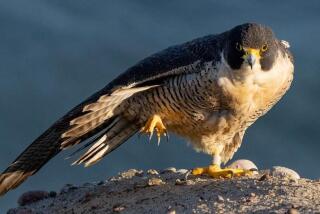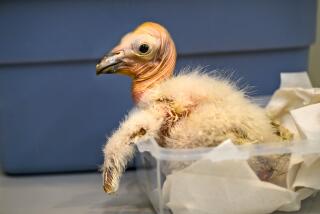Peregrines Become Part of Cityscape in Their Comeback
- Share via
Josephine Chen was sitting in her 14th-floor office recently when she saw a burst of gray and white feathers float past her window.
She shuddered, knowing that another pigeon had just been eaten by one of Glendale’s resident peregrine falcons.
The habits of the peregrine, a gull-sized bird that nests on building ledges as easily as on cliffs, may unsettle some like Chen, a building manager. But others see them as helping to control pigeon populations while restoring some of the wildlife that has been lost to city dwellers.
“They aren’t adapting to city life, they are simply doing what they’ve always done--nesting on ledges,” said Brian Walton, director of the Santa Cruz Predatory Bird Research Group.
The birds of prey, protected by state and federal law, number about 150 mating pairs in California. The peregrine is fast becoming one of the success stories of the endangered animal program, according to bird watchers and biologists.
“They’re a fantastic success story and will probably be coming off the endangered list next year,” Walton said.
About 10% of the state’s peregrine population lives on building ledges, he said.
“I’ve seen two of the birds now,” said Chen, whose 16-story office building on Brand Boulevard is a favorite hunting ground for the peregrine. “It’s sad to see the pigeons killed.”
For others, seeing peregrines kill pigeons is an affirmation of the success of the regal falcon, which nearly disappeared 25 years ago when the pesticide DDT poisoned the wild population to the brink of extinction, according to the bird research group. Roughly 1,500 pairs now live nationwide, according to the group.
DDT was pulled off the market in 1972 after ornithologists decried the compound’s lethal effects on wildlife, Walton said.
The peregrine, which rarely grows to weigh more than two pounds and hunts small and medium-sized birds, is classified as endangered by the U.S. Fish and Wildlife Service and the California Department of Fish and Game. Hunting the birds or moving nests is illegal; violations are punishable by a fine of a few hundred to a few thousand dollars, according to wildlife managers.
“There are a handful [of peregrines] nesting throughout Los Angeles County, maybe 10 to 15 pairs,” said Chanelle Davis, biologist for the state Department of Fish and Game. “They can be found in downtown L.A., Glendale and under the Vincent Thomas Bridge in San Pedro. They’re doing quite well.”
The falcons, which typically nest and mate with one partner throughout their lifetimes, establish territories within which they hunt and rear young, according to the U.S. Fish and Wildlife Service.
“They’re all over urban landscapes,” said Robert Mesta, a biologist with the agency. “The skyscrapers are perfect for them. They act as cliffs and the pigeons, which are all over cities, are an ideal food source.”
In Glendale, that food source has long irked city officials who, in 1993, passed a law banning feeding of the urban scavengers. The pigeon population had been growing yearly, according to Ritch Wells, a spokesman for the city.
“Glendale had a real bad pigeon problem and these falcons showed up and just decimated the population,” said Jack Kozaker, chief engineer of the Brand Boulevard skyscraper where Chen works. “As far as we’re concerned, the peregrines have really helped. Those pigeons make a serious waste problem. They defecate on buildings and cars and people walking on the street.”
With the peregrines and no-feeding law working in tandem, according to Wells, the pigeon problem has waned since 1993.
“The pigeons are still relatively plentiful and not the swiftest of birds,” said Russ Hauck, a park ranger for Glendale. “The peregrines just love to eat them.”
Although the Santa Cruz Predatory Bird Research Group keeps track of nesting pairs of falcons in the Los Angeles County region, it keeps the sites secret to preserve the birds’ safety from overzealous bird watchers, according to the group.
“Plus, the birds move from ledge to ledge quite frequently,” said Walton, director of the group. “They don’t build nests; they just live on ledges, so they can move without much effort.”
The peregrine is rather hard to find, because it spends so much of its time high in the air, Walton said. “They hunt their prey in the air, rarely on the ground,” he said. “So a lot of people just don’t ever see them.”
(BEGIN TEXT OF INFOBOX / INFOGRAPHIC)
Peregrine Falcon / Falco peregrinus
Pesticide almost wiped out this swift-flying bird of prey by causing infertility, but with 150 pairs in California, the peregrine is bouncing back.
* Size: 15-32 inches long, 40-inch wingspan.
* Habits: Usually hunts from high in the air, swooping onto prey such as small birds while in flight, at speeds of 100-plus mph.
* Habitat: Open country around rock cliffs and bluffs. In urban areas, they often nest on building ledges.
* Range: Northern part of North America, East and West coasts.
* Status: On state and federal endangered lists, but may be removed next year because of increased numbers.
Sources: “The Audubon Society Encyclopedia of North American Birds”; “The Audubon Society Field to North American Birds”
Los Angeles Times
More to Read
Sign up for Essential California
The most important California stories and recommendations in your inbox every morning.
You may occasionally receive promotional content from the Los Angeles Times.










